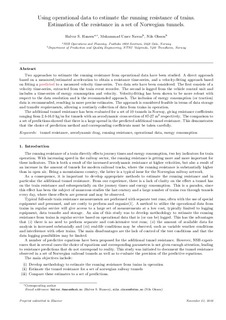Using operational data to estimate the running resistance of trains. Estimation of the resistance in a set of Norwegian tunnels
Journal article
Submitted version
Permanent lenke
http://hdl.handle.net/11250/2458431Utgivelsesdato
2017Metadata
Vis full innførselSamlinger
Originalversjon
Journal of Rail Transport Planning & Management. 2017, 7 (1-2), 62-76. https://doi.org/10.1016/j.jrtpm.2017.01.002Sammendrag
Two approaches to estimate the running resistance from operational data have been studied: A direct approach based on a measured/estimated acceleration to obtain a resistance time-series, and a velocity-fitting approach based on fitting a predicted to a measured velocity time-series. Two data sets have been considered: The first consists of a velocity time-series, extracted from the train event recorder. The second is logged from the vehicle control unit and includes a time-series of energy consumption and velocity. Velocity-fitting has been shown to be more robust with respect to the data resolution and is the recommended approach. The inclusion of energy consumption (or traction) data is recommended, resulting in more precise estimates. The approach is considered feasible in terms of data storage and transfer requirements, allowing a routinely collection of data from trains in operation.
The additional tunnel resistance has been evaluated for a set of 10 tunnels in Norway, giving resistance coefficients ranging from 2.4 to 16.0 kg/m for tunnels with an aerodynamic cross section of 87 to 27 m2 respectively. The comparison to a set of predictions showed that there is a large spread in the predicted additional tunnel resistance. This demonstrates that the choice of prediction method and corresponding coefficients must be taken carefully.
